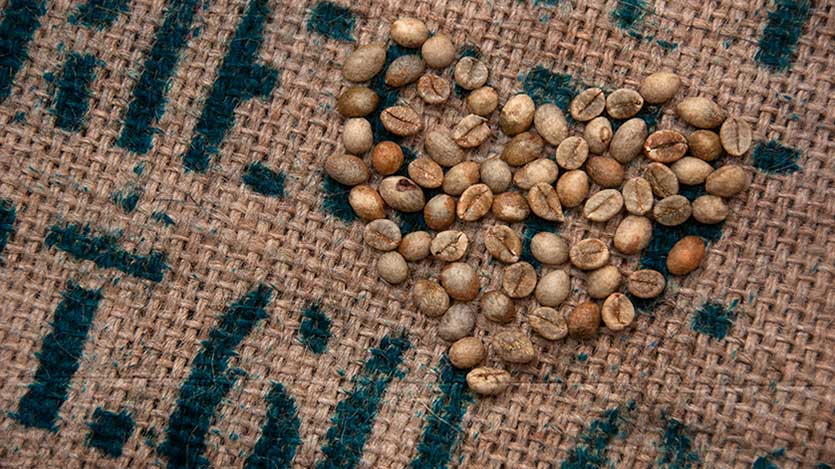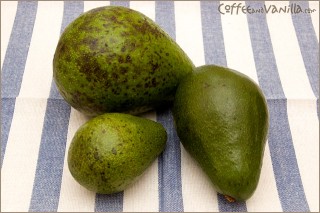The avocado (Persea americana) is a fruit plant native to Mexico, Central America, and Guam.
Avocados grow in the Caribbean, India, SriLanka, Australia, southern Spain, the Levant, South Africa, Peru, parts of central and northern Chile, Vietnam, Indonesia, New Zealand, the United States (California, Florida mostly), the Philippines, Malaysia, Mexico and Central America, the center of origin and diversity of this species. Each region has different types of cultivars. Mexico is the largest producer of the Hass variety, with over 1 million tonnes produced annually.
The tree grows to 20 meters (65 ft), the pear-shaped fruit is a true berry, from 7 to 20 centimeters long, weighs between 100 and 1000 grams, and has a large central seed, 5 – 6.4 centimeters long.
Avocados can have light green, dark green, through green-brown, brown to purple or almost black skin (Hass variety), they vary in flavour little bit, some are more nutty and buttery, some have more fresh and almost sweet taste. Different varieties of avocados have less fat then others.
The word “avocado” comes from the Spanish word aguacate, which derives in turn from the Nahuatl (Aztec) word ahuacatl, meaning “testicle” because of its shape. Historically avocados had a long-standing stigma as a sexual stimulant and were not purchased or consumed by any person wishing to preserve a chaste image. Growers had to sponsor a public relations campaign to debunk the avocado’s unsavory reputation before they eventually became popular. Avocados were known by the Aztecs as “the fertility fruit”. In some countries of South America such as Argentina, Bolivia, Chile, Peru, and Uruguay, the avocado is known by its Quechua name, palta. In other Spanish-speaking countries it is called aguacate, and in Portuguese it is abacate. The name “avocado pear” is sometimes used in English, as are “alligator pear” and “butter pear”. The Nahuatl ahuacatl can be compounded with other words, as in ahuacamolli, meaning “avocado soup or sauce”, from which the Mexican Spanish word guacamole derives.
The avocado is a climacteric fruit, which means that it matures on the tree but ripens off the tree. Avocados used in commerce are picked hard and green and kept in coolers until they reach their final destination. Avocado must be mature to ripen properly. Avocados that fall off the tree ripen on the ground, and depending on the amount of oil they contain, their taste and texture may vary greatly. Generally, the fruit is picked once it reaches maturity. Once picked, avocados ripen in a few days at room temperature (faster if stored with other fruits such as bananas, because of the influence of ethylene gas). Supermarkets sell pre-ripened avocados treated with synthetic ethylene to hasten the ripening process.
From personal experience I know it is very hard to find proper, ripe avocado in the shops here in UK, or even on the markets, most of the time they are not ripe enough, and even after sitting at home next to bananas for couple of days, they getting too soft and spoiled, but they never reach proper ripe state… The best way to check when avocado is ready to eat (ripe but still nice and firm) is too shake it, you should feel avocado seed moving inside! :) From all tree pictured avocados, only the biggest and the most ugly one was ready to eat.
A whole medium avocado contains approximately 21 grams of fat, though most of it is mono unsaturated fat. Avocados also have 60% more potassium than bananas. They are rich in B vitamins, as well as vitamin E and vitamin K. They have the highest fiber content of any fruit – including 75% insoluble and 25% soluble fiber.
The avocado flesh oxidizes and turns brown quickly after exposure to air. To prevent this, lime or lemon juice can be added to avocados after they are peeled.
Avocado is used as the base for the Mexican dip known as guacamole, as well as a filling for several kinds of sushi, including California rolls. Avocado is popular in chicken dishes and as a spread on toast, served with salt and pepper. In Brazil and Vietnam, avocados are considered sweet fruits, so are frequently used for milk-shakes and occasionally added to ice cream and other desserts. In Brazil, Vietnam, the Philippines and Indonesia, a dessert drink is made with sugar, milk or water, and pureed avocado. Chocolate syrup is sometimes added. In Central America, avocados are served mixed with white rice. In Chile its consumption is widespread and used as a puree in chicken, hamburgers and hot dogs, and in slices for celery or lettuce salads. The Chilean version of caesar salad contains large slices of mature avocado.
My favourite way is Avocado & Yogurt, as a Avocado & Crème Fraîche Dip or inside chicken, chicken-ham sandwich, it taste very good also on a toast with salmon pâté or just halved, sprinkled with salt to eat with a spoon as a side dish or itself ;)
There is documented evidence that animals such as cats, dogs, cattle, goats, rabbits, birds, parrots, fish and particularly, horses can be severely harmed or even killed when they consume the avocado leaves, bark, skin, or pit. The avocado fruit is poisonous to birds in some cases, so on a practical level feeding the fruit to birds should be avoided. Avocado leaves contain a toxic fatty acid derivative known as persin, which in sufficient quantity can cause equine colic and, with lack of veterinary treatment, death. Some humans can be also allergic to avocados.
Most of the information source: Wikipedia.


mmmmmm I LOVE avocados but they are getting so expensive these days! :(
Great and informative post on one of my favorite fruits. If I could eat it like an apple I would!
Also, the best thing I learned is that it comes from the spanish word meaning TESTICAL! love it… i’m going to discuss this with friends tomorrow when I meet them out for Mexican food. THey’ll love it…
amy @ we are never full
I do love avocados too but don’t have them enough in our house! Wonderful post Margot :D
Rosie x
Thanks for this post on avocados. I’m glad I read it as I have fed little bits of avocado to my cat who loves it. I’ll not be doing that again!
I agree 100% – the avocados you get here are useless most of the time. They go from too hard to eat, to black-fleshed and overripe and skip the smooth, creamy, ripe stage altogether! In South Africa we used to buy big bags of 10 at the roadside for the equivalent of a pound – sigh.
Just had to add my 2 cents…. my family is from Cuba and Puerto Rico, and we eat sliced avocados as a side dish or as part of a green salad, sprinkled with some sea salt and olive oil. It is also not uncommon to eat them straight from the shell with a spoon haha! So poster #2 (We are Never Full)….. you CAN eat them like an apple… maybe not bite into it, but close enough!
Thank you all for comments.
I just had nice salad for lunch with some avocados and roasted peppers… I will post recipe soon :)
Dee – I have never been to Cuba, but to Puerto Rico yes (working on the cruise ship) and I know that halves of avocados are served on the side as a salad… to eat with a spoon, hehe… :) They taste perfect also in sandwiches.
I have a couple of avocado “plants” that I have grow up to about 5 ft. indoors. I live in MA and I would like to bring them outside… Can I dig them up in the winter and bring them in so they don’t die or is there a way to protect them in the winter from freezing and dieing? Also, does anyone know how tall they are before they bear fruit? Can I give it food to help it produce fruit? The leaves are gorgeous! Deep dark green and the leaves are huge! Thank you so much.. I love avocados!
Donna – I don’t know myself much about planting avocados, maybe someone will know answer to that. I tried once, I grew much too large to keep it in the room, I lived in Warsaw at that time, no garden… and I had to give it away :(
i just had some avocado on toast for brekfast, i must admit i dont really like the taste. but i wish i did